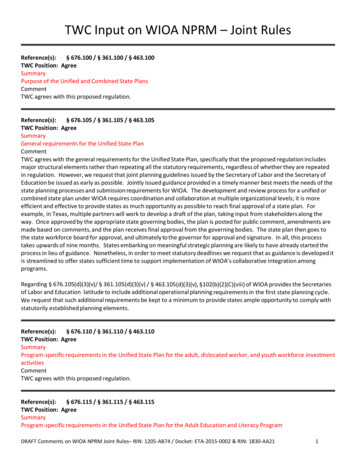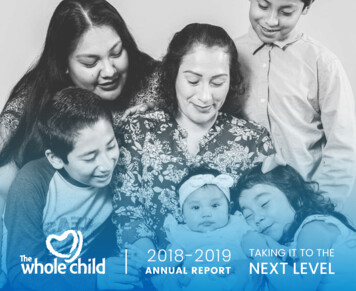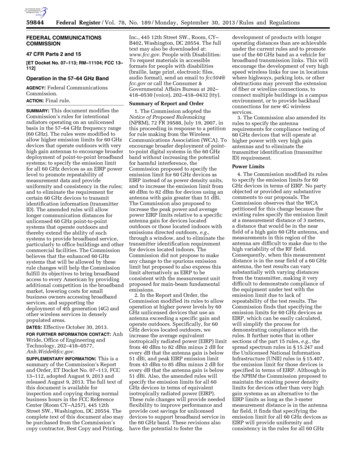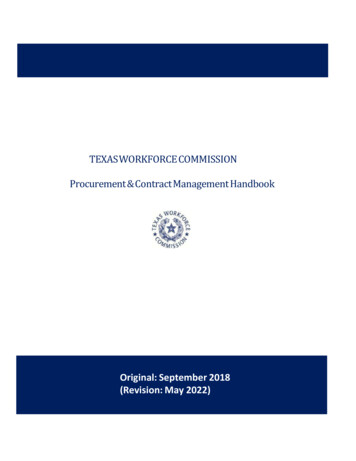
Transcription
TWC Input on WIOA NPRM – Joint RulesReference(s):§ 676.100 / § 361.100 / § 463.100TWC Position: AgreeSummaryPurpose of the Unified and Combined State PlansCommentTWC agrees with this proposed regulation.Reference(s):§ 676.105 / § 361.105 / § 463.105TWC Position: AgreeSummaryGeneral requirements for the Unified State PlanCommentTWC agrees with the general requirements for the Unified State Plan, specifically that the proposed regulation includesmajor structural elements rather than repeating all the statutory requirements, regardless of whether they are repeatedin regulation. However, we request that joint planning guidelines issued by the Secretary of Labor and the Secretary ofEducation be issued as early as possible. Jointly issued guidance provided in a timely manner best meets the needs of thestate planning processes and submission requirements for WIOA. The development and review process for a unified orcombined state plan under WIOA requires coordination and collaboration at multiple organizational levels; it is moreefficient and effective to provide states as much opportunity as possible to reach final approval of a state plan. Forexample, in Texas, multiple partners will work to develop a draft of the plan, taking input from stakeholders along theway. Once approved by the appropriate state governing bodies, the plan is posted for public comment, amendments aremade based on comments, and the plan receives final approval from the governing bodies. The state plan then goes tothe state workforce board for approval, and ultimately to the governor for approval and signature. In all, this processtakes upwards of nine months. States embarking on meaningful strategic planning are likely to have already started theprocess in lieu of guidance. Nonetheless, in order to meet statutory deadlines we request that as guidance is developed itis streamlined to offer states sufficient time to support implementation of WIOA’s collaborative integration amongprograms.Regarding § 676.105(d)(3)(v)/ § 361.105(d)(3)(v) / § 463.105(d)(3)(v), §102(b)(2)(C)(viii) of WIOA provides the Secretariesof Labor and Education latitude to include additional operational planning requirements in the first state planning cycle.We request that such additional requirements be kept to a minimum to provide states ample opportunity to comply withstatutorily established planning elements.Reference(s):§ 676.110 / § 361.110 / § 463.110TWC Position: AgreeSummaryProgram‐specific requirements in the Unified State Plan for the adult, dislocated worker, and youth workforce investmentactivitiesCommentTWC agrees with this proposed regulation.Reference(s):§ 676.115 / § 361.115 / § 463.115TWC Position: AgreeSummaryProgram‐specific requirements in the Unified State Plan for the Adult Education and Literacy ProgramDRAFT Comments on WIOA NPRM Joint Rules– RIN: 1205-AB74 / Docket: ETA-2015-0002 & RIN: 1830-AA211
CommentTWC supports the regulation as proposed.Reference(s):§ 676.120 / § 361.120 / § 463.120TWC Position: AgreeSummaryProgram‐specific requirements in the Unified State Plan for Wagner‐Peyser Act Employment Service programsCommentTWC agrees with this proposed regulation.Reference(s):§ 676.125 / § 361.125 / § 463.125TWC Position: AgreeSummaryProgram‐specific requirements in the Unified State Plan for the State Vocational Rehabilitation programCommentTWC agrees with this proposed regulation.Reference(s):§ 676.130 / § 361.130 / § 463.130TWC Position: AgreeSummarySubmission and approval process of the Unified State PlanCommentTWC supports openness and transparency in all planning efforts, and as such, planning elements will be a component ofregularly scheduled meetings of TWC’s three-member Commission, in which all stakeholders are assured of having theopportunity to provide public comment on issues. Throughout the process, the public also is provided additionalopportunities to give feedback on the plan. We would also like to point out the following inconsistency in regards to planreview and approval: The statute (WIOA §102(c)(2)(b)) indicates approval 90 days after submission; however, §676.130(g) /§ 361.130(g) / § 463.130(g) states 90 days of receipt. This is a relatively minor issue if an electronic medium (e-mail) isused for transmitting the plan.Reference(s):§ 676.130(g) / § 361.130(g) / § 463.130(g)TWC Position: ConflictsSummarySubmission and approval process of the Unified State PlanCommentSections 676.130(g) / § 361.130(g) / § 463.130(g) conflict with statute. Sections 676.130(g) / § 361.130(g) / § 463.130(g) statethat “the Secretary of Labor and the Secretary of Education will review and approve the Unified State Plan within 90 daysof receipt by the appropriate Secretary unless the Secretary of Labor or the Secretary of Education determines in writingwithin that period that .” However, WIOA §102(c)(2)(b) provides that the plan shall be considered approved at the end ofthe 90-day period beginning on the day the plan is submitted. TWC recommends that the terminology for establishing thestart of the time frame for review and approval of plans be consistent and that a definition be provided for determiningthat start date.Reference(s):§ 676.135 / § 361.135 / § 463.135TWC Position: Conditionally AgreeSummaryRequirements for modification of the Unified State PlanDRAFT Comments on WIOA NPRM Joint Rules– RIN: 1205-AB74 / Docket: ETA-2015-0002 & RIN: 1830-AA212
CommentTWC supports a review of the state plan at the end of the first two-year period, as set forth in §676.135(b)(1) / §361.135(b) (1) / § 463.135(b)(1), but recommends that modifications to the plan should only be necessary in the event ofsignificant or substantial changes in labor market and economic conditions or other factors significantly affectingimplementation of the plan, as is prescribed for modifications to the regional plan and local plan (proposed §679.580(b)).States should also have the flexibility to define what constitutes a major change. Plan modifications necessitated by minorchanges are burdensome and siphon valuable resources from implementation efforts.Proposed modification to §676.135(b)(1) / § 361.135(b)(1) / § 463.135(b)(1): “At the end of the first 2-year period of any4- year State Plan, wherein the State Board must review the Unified State Plan, and the Governor must submitmodifications to the plan to reflect major changes in labor market and economic conditions or other factors, as definedby states, affecting the implementation of the Unified State Plan ”Reference(s):§ 676.140 / § 361.140 / § 463.140TWC Position: Conditionally AgreeSummaryGeneral requirements for submitting a Combined State PlanCommentTWC agrees with the general requirements for submitting a combined state plan. Specifically§ 676.135(b) / § 361.135(b)/ §463.135(b) state that states will "not be required to submit any other plan or application in order to receive Federalfunds to carry out the core programs or the program or activities that are covered by the Combined State Plan."However, TWC requests that joint planning guidelines issued by the Secretary of Labor and the Secretary of Education beissued as early as possible. Jointly issued guidance provided in a timely manner best meets the needs of state planningprocesses and the submission requirements for WIOA, and provides states the necessary time to comply with guidance.The development and review process for a combined plan under WIOA requires coordination and collaboration atmultiple organizational levels; it is more efficient and effective to provide states as much opportunity as possible to reachfinal approval of a state plan, and for most states the ultimate approval of a plan at the state level is a multiprongedprocess. For example, in Texas, multiple partners would work to develop a draft of the plan, taking input fromstakeholders along the way. Once approved by the appropriate state governing bodies, the plan is posted for publiccomment, amendments are made based on comments, and the plan receives final approval from said governing bodies.Then the plan goes to the state workforce board for approval, and ultimately to the governor for approval and signature.In all, this process takes upwards of nine months. States embarking on meaningful strategic planning are likely to havealready started the process in lieu of guidance. Nonetheless, in order to meet statutory deadlines, we request that asguidance is developed, it is streamlined to offer states sufficient time to support implementation of WIOA’s collaborativeintegration among programs.In its preamble, the Departments note “the 4-year cycle, with a 2-year modification, for the Combined State Plan isinconsistent with the planning cycles for the plans governing the optional programs. The Departments seek comment onhow to address this issue and reduce the burden of managing multiple cycles.“Specifically, the Departments request comment on how to treat the plan for an optional program whose planning cycle islonger than 2 years, whose planning cycle is less than 2 years, and whose planning process includes intra-cyclemodifications of the plan, and similarly, the Departments request comments on how best to treat the plan for an optionalprogram that is reauthorized or otherwise significantly amended during the 4-year or 2-year cycle of a Combined StatePlan, including a change to the optional program’s planning cycle.”TWC recommends keeping the approval of the core programs separate and apart from the approval of noncore programs,such that the implementation of what would otherwise be an approved Unified State Plan is not impacted or held up bydecisions on noncore program cycles. Further, TWC recommends that planning components for programs considerednoncore under WIOA—TANF, for example—be separated out so that one or more existing components could be approvedas a part of the WIOA combined plan, and states would not have to resubmit components that have already beenDRAFT Comments on WIOA NPRM Joint Rules– RIN: 1205-AB74 / Docket: ETA-2015-0002 & RIN: 1830-AA213
approved under the WIOA combined plan to the respective federal agency. For example, Texas would include the TANFemployment and training component in its WIOA combined plan, but not include this component (at least for officialapproval purposes) in Texas’ state TANF plan. This approach would be of value to states like Texas, where oversight ofindividual components of a program is split between multiple state agencies.Reference(s):§ 676.143(b) / § 361.143(b) / § 463.143(b)TWC Position: DisagreeSummarySubmission and approval process of the Combined State PlanCommentRegarding §676.143(b) / § 361.143(b) / § 463.143(b), TWC recommends that for purposes of efficiency, the Secretaries ofLabor and Education transmit the combined plan to the secretary of the agency with responsibility for approving theprogram’s plan or determining it complete. This will help reduce the burden on states that are required to send plans tomultiple federal entities. The Secretaries of Labor and Education may want to consider taking all of the combined plansand submitting them as a batch to the other appropriate federal entities. TWC proposes that §676.143(b) / § 361.143(b) /§463.143(b) be modified as follows:(b) The State must submit its combined plan to the Secretaries of Labor and Education. The Secretaries of Labor andEducation shall coordinate the transmittal of the plan and to the Secretary of the agency with responsibility forapproving the program’s plan or determining it complete under the law governing the program, as part of itsCombined State Plan. Any additional plan, application, form, or any other similar document that is required as acondition for the approval of Federal funding under the applicable program or activity must be provided by the stateupon request of the Secretary of the agency with responsibility for approving the program’s plan or determining itcomplete. Such submission must occur in accordance with a process identified by the relevant Secretaries inparagraph (a) of this section.Reference(s):§ 676.143(d) / § 361.143(d) / § 463.143(d)TWC Position: DisagreeSummarySubmission and approval process of the Combined State Plan‐ plan approval, optional programsCommentTWC disagrees with §676.143(d) / § 361.143(d) / § 463.143(d). Sections 676.143(d)(1)–(3) / § 361.143(d)(1)–(3) / §463.143(d) (1)–(3) state that “the plan may not be approved if the relevant Secretary determines, in writing, within therelevant review period that: the plan is inconsistent with the requirements of the core programs or one or more of theoptional programs included; does not meet the criteria for the core programs or one or more of the optional programsincluded; or is considered incomplete or insufficient to make an approval determination.”The provisions set forth in §676.143(d)(1)–(3) / § 361.143(d)(1)–(3) / § 463.143(d)(1)–(3) imply that disapproval by anysecretary of their respective program will result in disapproval of the combined state plan as a whole. This positionprovides an incentive to submit a unified state plan, not a combined state plan, which the Secretaries encourage. TWCrecommends that the disapproval of a section of the plan pertaining to a noncore program not result in disapproval of theentire plan.Reference(s):§ 676.145 / § 361.145 / § 463.145TWC Position: Conditionally AgreeSummaryRequirements for modifications of the Combined State PlanCommentDRAFT Comments on WIOA NPRM Joint Rules– RIN: 1205-AB74 / Docket: ETA-2015-0002 & RIN: 1830-AA214
TWC agrees with the requirements set forth in this section, but asks for clarification in regards to §676.145(f) / §361.145(f) / § 463.145(f). Sections 676.145(f) / § 361.145(f) / § 463.145(f) state that “Modifications for the portions ofthe Combined State Plan for any optional program or activity described in §676.145(d) must be submitted for approval byonly the appropriate Secretary.” TWC requests that §676.145(f) / § 361.145(f) / § 463.145(f) be amended as follows:“Modifications for the portions of the Combined State Plan for any optional program or activity described in §676.145(d)must be submitted for approval by to only the appropriate Secretary.”In its preamble, the Departments “seek comment on how to streamline the public review and comment process forCombined State Plan modifications; whether it is advisable to limit the comment process to significant or substantialmodifications to the common planning elements; and, if so, how the Departments might define significant or substantialchanges.”Based on current rules, TWC recommends keeping the approval of the core programs separate and apart from theapproval of noncore programs, such that the implementation of what would otherwise be an approved Unified State Planis not impacted or held up by decisions on noncore program cycles. As such, it is advisable to limit the comment processto significant or substantial modifications to the common planning elements. TWC supports streamlining the publicreview process; however rules governing other programs in many cases do not align. Alignment of the public reviewprocess at a federal level for all workforce programs would be of great benefit to states. In regards to the definition ofsignificant or substantial change for plan modification purposes, TWC recommends using existing 20 CFR §661.230,specifically (b)(1)–(3):(a) The State may submit a modification of its workforce investment plan at any time during the five- year life of theplan.(b) Modifications are required when:(1) Changes in Federal or State law or policy substantially change the assumptions upon which the plan is based.(2) There are changes in the Statewide vision, strategies, policies, performance indicators, the methodologyused to determine local allocation of funds, reorganizations which change the working relationship withsystem employees, changes in organizational responsibilities, changes to the membership structure of the StateBoard or alternative entity and similar substantial changes to the State’s workforce investment system.(3) The State has failed to meet performance goals, and must adjust service strategies.If this definition is not used, TWC recommends providing states the flexibility to determine what “significant or substantialchanges” mean to them, recognizing that the meaning could differ, depending on state and local conditions.Reference(s):§ 677 / § 361 / § 463TWC Position: Conditionally AgreeSummaryPerformance Accountability Under Title I of the Workforce Innovation and Opportunity Act ‐ Overview of CommentsCommentTWC strongly supports the alignment of performance and reporting duties of the six core programs under WIOA but isconcerned with some of the proposals in Part IVB of RIN1205-AB74 and RIN1830-AA21, hereafter referred to as thePerformance Accountability Regulations. In particular, TWC is concerned with the following:1) The Performance Accountability Regulations do not provide sufficient specificity regarding the performancecalculations to ensure consistent interpretation and application across programs. This lack of specificity, coupledwith communications by federal staff subsequent to WIOA passage (but prior to issuance of the regulations),leave TWC concerned that OCTAE either sees the current AEFLA performance accountability system as consistentDRAFT Comments on WIOA NPRM Joint Rules– RIN: 1205-AB74 / Docket: ETA-2015-0002 & RIN: 1830-AA215
with WIOA or is making the absolute minimum changes necessary to create the appearance of consistency. TWCbelieves the WIOA performance accountability system is very different from the existing system, particularly forAEFLA. Further, even if it were possible to shoehorn the existing system into the WIOA structure, it wouldimpede further integration and alignment of the six core programs because program-level performancecalculations for Participants in multiple programs would differ, leading to the same siloed thinking about successthat existed between WIA and Wagner-Peyser before development of the original Common Measures.2) The NPRM requires submission of customer-level data for five of the core programs but excludes AEFLA customerdata. TWC is concerned that this will hinder integration and shared accountability between Titles I–IV. Further,the Departments will need customer-level data to develop the WIOA-required statistical adjustment models usedin target setting. Current AEFLA National Reporting System (NRS) data is insufficient to effectively develop thesemodels. The provisions relating to the statistical adjustment models in the proposed regulations specify that themodels will not be applied until the data necessary to populate them is available. If the Department of Educationdoesn’t have or propose to obtain the necessary data, there is a built-in excuse to continue the current targetsetting model indefinitely.3) The exclusion of all self-serve-only customers from the definition of “Participant” is inappropriate in an age inwhich our customers seek workforce assistance at any place and any time, and given that states and localworkforce partners have made substantial investments developing IT systems to create a robust self-serviceexperience. This lack of focus on the customer is not appropriate, as it limits access and maintains a focus onprocess rather than outcomes. Further, TWC views as problematic the suggestion that an individual receivingstaff assistance should retroactively exit on the date that staff assistance was provided, as assistance may includean Individualized Plan for Employment (IPE) the Participant is then to follow via self-service. This approach wouldeither reduce reportable performance by having customers Exit while still engaged in a meaningful job search viaself-service or promote inefficiency by requiring staff to provide a service that might not be needed, just toprevent an Exit while the individual is following his or her IPE.4) The regulations fail to meaningfully clarify the statutory term “levels of performance,” which on its face appearsto refer to the levels of performance actually achieved, but which in the statute actually means “expected levelsof performance” (i.e., targets). To ensure consistent interpretation and application of the regulations, TWCrecommends that “levels of performance” be replaced with “targets” or “expected levels of performance”throughout the regulations.5) TWC is very concerned that a number of provisions in the Performance Accountability and Reporting section, aswell as section of the other NPRM, provide both disincentives to actions that are in our customers’ best interestand strong, perverse incentives to behave in a manner that is actually against our customers’ interests andneeds. For example, a measure that only focuses on the measurable skills gain in lowest educational area—eventhough an individual might have multiple areas of deficiency—provides a disincentive to focusing on thoseadditional areas.Good measures are aligned with the customer’s needs and the system’s goals. That is, strong performance isachieved by acting in the customer’s best interest. Measures in which high performance can be achieved byacting against the interest of the customer undercut accountability and undermine the integrity of andconfidence in the public workforce system.Performance measures influence behavior. TWC has taken advantage of this reality over the years by creatingand modifying performance measures for specific purposes. For example, 12 years ago, when a relatively smallproportion of Texas employers used the workforce system, TWC developed a performance measure intended toincrease system use. The result was a nearly 200 percent increase in employer usage. TWC also responded torelatively slow reemployment of unemployment insurance (UI) claimants by creating a measure that challengedour Local Workforce Development Boards (Boards) to improve return to work within 10 weeks, which more thandoubled.DRAFT Comments on WIOA NPRM Joint Rules– RIN: 1205-AB74 / Docket: ETA-2015-0002 & RIN: 1830-AA216
Reference(s):§ 677.150 / § 361.150 / § 463.150TWC Position: DisagreeSummaryPerformance definitions for WIOACommentTWC supports elements of the proposed definition of “Participant” and the idea that not all “Reportable Individuals,”including those who have minimally accessed services, should be considered Participants. TWC has long sought a way toseparate the “curious” from the “committed” job seeker, as other partner programs such as AEFLA and VR have done,and sees an opportunity to do so in these regulations.TWC supports the proposal that an individual not be considered an AEFLA program Participant if he or she does notcomplete at least 12 contact hours in the AEFLA program, and that an individual not be considered a VocationalRehabilitation (VR) Participant unless he or she has an approved and signed IPE and has begun to receive services. Bothof these definitions clearly create a threshold that an individual must cross in order to be considered a Participant—demonstration of a commitment to using/receiving system services.However, Participants under Titles I and III need not demonstrate any such commitment to using the workforce systemto support their employment and career goals. Instead, the proposal calls for exclusion of all self-service-only individualsfrom the definition of Participant and the inclusion of all individuals who receive staff-assisted services (other than thosereceiving only staff-assisted informational services). This means that an individual who is part of a group orientation butwho then never uses any additional system services is considered a Participant. At the same time, an individual whodemonstrates clear commitment to using the system by researching career pathway information, registering for jobmatching, and regularly using the job matching system for weeks on end—perhaps even getting a job found throughthat system—is not a Participant.The Departments explain the proposed exclusion of self-service-only individuals as Participants because they “haveminimal interaction with the program and minimal resources are spent on their behalf.” TWC disagrees and believesthat it is often appropriate to include self-service individuals in the definition of Participant for a number of reasons:1) Many self-service-only individuals actively use these services over a period of weeks or months as an importantpart of their efforts to achieve their employment or career goals.2) Providing robust, effective self-service tools requires far more than “minimal resources.” Indeed, as more ofthose using our system primarily access the Internet via their phones, to remain relevant and better servetoday’s customer, the One-Stop system will be forced to spend millions of dollars nationally to update selfservice options to be more mobile-friendly. TWC examined national PY12 and PY13 Wagner-Peyser data andfound several important pieces of information relative to this point.a. First, TWC found that the proportion of Participants served via self-service-only rose from 29.5% to40.37%.b. Second, TWC found that younger people were more likely to choose self-service only. In PY13, 41.35%of those 30 were self-service-only while 37.55% of those 40 were self-service only.3) While national data shows an increased reliance on self-service options, some of that trend may be the result ofstaff-work in the One-Stops. Today’s self-service-only customers were yesterday’s staff-assisted customers,having learned how to get maximum value out of the self-service tools. TWC examined national PY12 WagnerPeyser data and found that while 29% of those served in PY12 received self-services only, over half of thoseindividuals had one or more earlier Periods of Participations within the six quarters prior to PY12 that did involvestaff-assisted services. In many states, the percentage of self-service-only customers who had staff-assistedDRAFT Comments on WIOA NPRM Joint Rules– RIN: 1205-AB74 / Docket: ETA-2015-0002 & RIN: 1830-AA217
Periods of Participation prior to their self-service Periods of Participation was well above 70%. There is no basisfor excluding the same customers from the Participant definition based on their choice to access the sameservices via a different method.4) The proposed regulations incorrectly assume that staff-assisted service represents significant costs, while selfservice requires minimal resources. TWC disagrees with using cost as the deciding factor in determiningwhether an individual is a Participant, but to the extent that cost is a factor, it is faulty logic to assume theprovision of a single staff-assisted service necessarily represents significant costs.5) WIOA requires consideration of return on investment of federal funds in evaluating performance and settingtargets. Excluding self-service-only individuals and their outcomes inhibits that effort and will provide adisincentive to improve tools that support these services.6) Self-service should not be presumed to indicate the absence of staff involvement. Staff plays a significant role inensuring that Participants achieve positive employment and career outcomes through self-service. In particular,staff is often responsible for recruiting employers to use the One-Stop system and even entering employer joborders into the job matching/labor exchange system, to which Participants can then match via self-service.7) The exclusion of self-service-only customers from performance accountability shows a bias against rural areas,which are less likely to have easily reachable One-Stop centers.8) While not an issue in Texas, where TWC and the Boards use integrated measures to remove incentives toselectively serve customers, the exclusion of self-service-only individuals from the definition of Participant maycreate an incentive to selectively serve job seekers. Job seekers deemed least likely to have positiveperformance outcomes might be relegated to self-service-only, to exclude them from performance. This wouldstand in direct opposition to one of WIOA’s six purposes, “increasing access to and opportunities for theemployment, education, training, and support services for individuals, particularly those with barriers toemployment” (emphasis added).Finally, the NPRM suggests that excluding self-service-only individuals from the definition of Participant would “addressinconsistency in reporting based on various coenrollment strategies.” The Departments were likely referring todifferences in enrollment strategies between Wagner-Peyser and WIA customers used by states prior to WIOA.Prior to WIOA, most states considered Wagner-Peyser the universal workforce services program and WIA a morespecialized program, with enrollment limited to job seekers who needed significant additional assistance such asoccupational training or supportive services. WIA and Wagner-Peyser performance in these “traditional states” wasusually fairly different, particularly for Entered Employment.Other states adopted a “universal” coenrollment strategy, whereby all or nearly all Wagner-Peyser job seekers were alsoenrolled in WIA, but only a small portion of those job seekers received training or supportive services. This resulted inWIA and Wagner-Peyser performance, which was largely indistinguishable.These different enrollment strategies made WIA performance less comparable from state to state. However, theproposed exclusion of self-service-only individuals from the definition of Participant, and thus from performancecalculations, will have little impact on the issue of comparability among states. TWC has examined PY12 Wagner-Peyserdata by state and found that only 5.78% of Wagner-Peyser Participants served in New York (perhaps the biggestuniversal coenrollment state) were self-serve only. Excluding those customers would not meaningfully change Title Iperformance in a way that would improve comparability between states. Title I
TWC supports the regulation as proposed. Reference(s): § 676.120 / § 361.120 / § 463.120. TWC Position: Agree. Summary . Program-specific requirements in the Unified State Plan for Wagner-Peyser Act Employment Service programs . Comment . TWC agrees with this proposed regulation. Reference(s): § 676.125 / § 361.125 / § 463.125. TWC .










